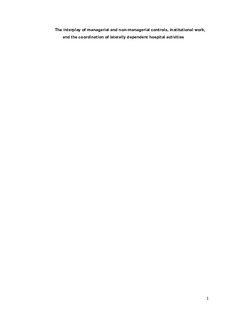| dc.contributor.author | Nyland, Kari | |
| dc.contributor.author | Morland, Charlotte | |
| dc.contributor.author | Burns, John | |
| dc.date.accessioned | 2018-04-10T07:19:36Z | |
| dc.date.available | 2018-04-10T07:19:36Z | |
| dc.date.created | 2017-11-27T10:19:22Z | |
| dc.date.issued | 2017 | |
| dc.identifier.citation | Qualitative Research in Accounting and Management. 2017, 14 (4), 467-495. | nb_NO |
| dc.identifier.issn | 1176-6093 | |
| dc.identifier.uri | http://hdl.handle.net/11250/2493311 | |
| dc.description.abstract | Purpose
The purpose of this paper is to explore two hospital departments, one of which is laterally dependent on the other to function, but which are subject to distinct vertical managerial controls. This complexity in vertical–lateral relations generates tension amongst the hospital’s senior managers and a perception of coordination difficulties. However, this paper shows how the interplay between managerial and non-managerial controls, plus important employee “work”, moderates tension and facilitates day-to-day lateral coordination at the patient-facing level.
Design/methodology/approach
This is a case-study, relying mostly on the findings of semi-structured interviews. Theoretically, the paper draws from previous insights on inter-organisational relations (but informing the focus on intra-organisational coordination) and an “institutional work” perspective.
Findings
Consistent with much extant literature, this paper reveals how non-managerial controls help to moderate tensions that could emerge from the coercive use of managerial controls. However, the authors also show a maintained influence and flexibility in the managerial controls at patient-facing levels, as new circumstances unfold.
Research limitations/implications
The findings of this paper could generalise neither all laterally dependent spaces in hospitals nor patterns across different hospitals. The authors recommend future research into the dynamics and interaction of managerial and non-managerial controls in other complex settings, plus focus on the purposeful work of influential agents.
Originality/value
The paper has two primary contributions: extending our knowledge of the interplay between managerial and non-managerial controls inside complex organisations, where non-managerial controls reinforce rather than displace managerial controls, and highlighting that it is seldom just controls per se which “matter”, but also agents’ purposeful actions that facilitate coordination in complex organisations. | nb_NO |
| dc.language.iso | eng | nb_NO |
| dc.publisher | Emerald | nb_NO |
| dc.title | The interplay of managerial and non-managerial controls, institutional work, and the coordination of laterally dependent hospital activities | nb_NO |
| dc.type | Journal article | nb_NO |
| dc.description.version | submittedVersion | nb_NO |
| dc.source.pagenumber | 467-495 | nb_NO |
| dc.source.volume | 14 | nb_NO |
| dc.source.journal | Qualitative Research in Accounting and Management | nb_NO |
| dc.source.issue | 4 | nb_NO |
| dc.identifier.doi | 10.1108/QRAM-08-2017-0076 | |
| dc.identifier.cristin | 1518687 | |
| dc.relation.project | Regionale forskningsfond Midt-Norge: 249080 | nb_NO |
| dc.description.localcode | This is a submitted manuscript of an article published by Emerald in Qualitative Research in Accounting and Management, 2017 | nb_NO |
| cristin.unitcode | 194,60,10,0 | |
| cristin.unitname | NTNU Handelshøyskolen | |
| cristin.ispublished | true | |
| cristin.fulltext | preprint | |
| cristin.qualitycode | 1 | |
